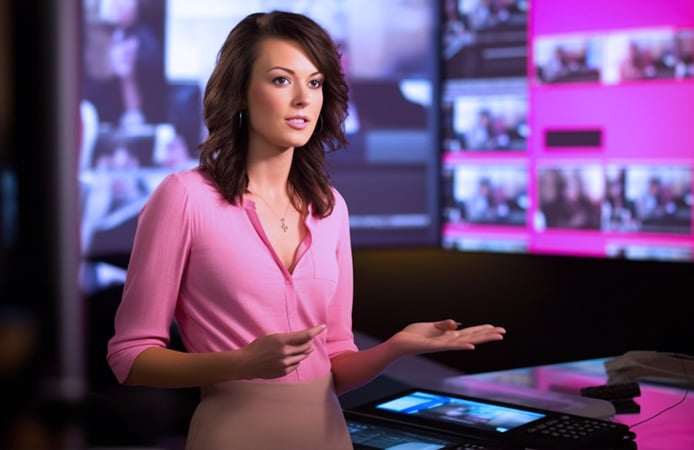Captioning is a factor in practically every video seen on YouTube and social media, with these platforms offering it as a standard feature. While captioning was invented to support people who are hard of hearing, the attraction of captioning has expanded well beyond this demographic.
A study on the education sector found that 54% of students used captioning “at least some of the time.” If you are thinking about adding captions to your content, you must consider open captions vs. closed captions, their differences, and their pros and cons. This article addresses these issues to help you decide on captioning.
Table of Contents
What is Closed Captioning?
Closed or open — which option is best for you? Firstly, closed captioning is by far the most common type of captioning available, used by major content platforms like Facebook, YouTube, and Vimeo by default.
If closed captioning is open, you’ll notice the [CC] logo on the video player. Since they are “closed,” users can switch them on and off at will.
Closed captions are a powerful tool, with countless statistics proving they are worth investing in the technology. For example, according to Facebook’s statistics, closed captions increased average watch time by 12%.
They also increased the likelihood that users will finish watching a Facebook video by 80%, which is critical in an era where users have more choices than ever.
Pros and Cons
The primary advantage of closed captioning is flexibility. Users can switch them on and off at will by pressing a button. Moreover, from a content creator’s perspective, they can easily edit closed captions because they exist within a separate file, which can come in various formats.
The downside is that closed captioning isn’t compatible with all streaming services and some media players. Furthermore, closed captions rely on the user knowing how to switch them on, which can be problematic if your target audience is unfamiliar with the technology.
What is Open Captioning?
Open captioning resembles closed captioning with one key difference. These captions are embedded on the screen.
So, what does open captions mean for the viewer? In short, they have no choice over whether to view these captions. They are part of the original video file and form a core part of the production.
While this may sound like it closes the debate on open caption vs. closed caption, the former still plays an essential role in specific shows. For example, what does open caption mean at the movies? In some dedicated showings, the open caption movies meaning may pertain to films aimed at those with specific hearing disabilities.
With approximately 48 million Americans suffering hearing loss, this is more common than many might think. So, even though open captions aren’t as prominent as in the past, they still have a role to play.
Pros and Cons
Open captions benefit those who do not understand technology because switching them on or off is unnecessary. Additionally, since they’re part of the media file, no restrictions exist on where open captions can be shown.
Finally, an open caption’s style can be determined ahead of time, meaning you can adjust the size, font, and color, which isn’t available with closed captioning.
The obvious problem is that users are locked into viewing subtitles on the screen. They have zero flexibility or freedom of choice. Another problem is that if the caption or video quality could be better, so will the resulting subtitles, making it critical that open captions are reviewed and redrafted to perfection.
Open Caption vs. Closed Caption: Which is Right for You?
Understanding what is an open caption and what does an open caption mean in comparison to closed captioning is the first step to determining which options you should use.
In this guide, we’ll compare open caption vs. closed caption to help you find the best solution.
Use Cases
All pre-recorded productions are compatible with both open and closed captioning. However, if opting for live captioning, you’ll need to rely on closed captioning because open captioning cannot be done in real-time.
Examples
The most common use for open captions is in movies. For example, these captions will display automatically if the movie includes different languages. Likewise, if a foreign film is shown to an English-speaking audience, the entire movie will have open captions.
In contrast, closed captioning is the default option for all types of online videos, including pre-recorded and live content. Examples include YouTube videos, product demos, webinars, interviews, and lectures.
Editing
Do you regularly update your content? In this case, closed captioning is the best option. Since they’re stored in a separate file, they can be edited in seconds. Editing open captions means taking on the time-consuming task of editing an entire video file from scratch.
Audience
Your audience is also relevant because closed captioning requires knowing how to activate/deactivate them. Open captions may be better if your content is aimed at children or seniors. Likewise, if you are producing content specifically for people who are hard of hearing, open captions are the superior solution.
Compatibility
Think about where you intend to display your content. If your video content exists solely on a specific platform, such as YouTube or Facebook, these players are guaranteed to support closed captioning.
However, if providing downloadable content, making an open caption file available can overcome video player compatibility issues.
Option Your Captions Effortlessly with Sonix
Closed captioning makes up practically all subtitles today because of its flexibility. However, open captions still have a place, and you must know when to implement them.
Sonix AI makes creating highly accurate captions easy with our intuitive transcription software. Equipping your business with our advanced technology allows you to develop transcriptions for captioning in minutes. You can even translate voice to text in over 40 languages. To discover the power of AI-powered transcription, try our advanced automatic transcription software for free today!

